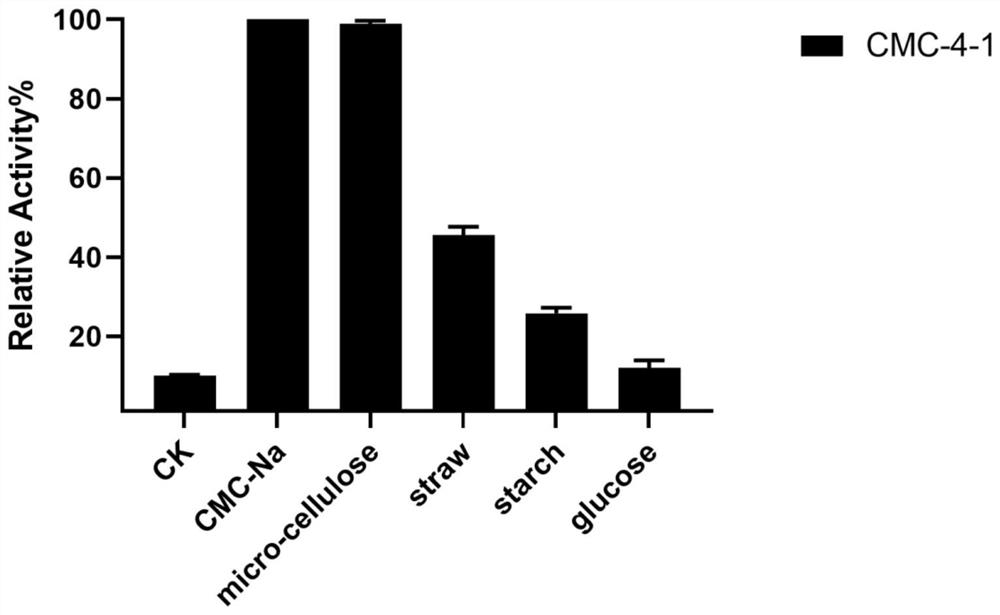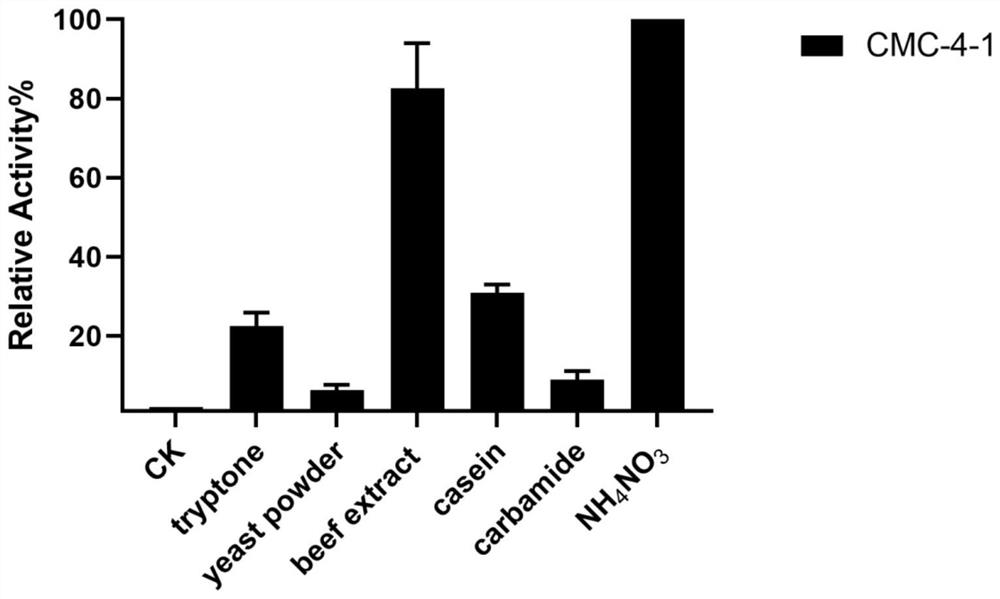Geobacillus thermodenitrificans obtained by artificial mutagenesis and application thereof in cellulose degradation
A thermoglucosidase, Geobacillus technology, applied in the field of microorganisms, can solve the problem that P.thermoglucosidasius has not been reported in cellulose degradation, and achieve the effect of high enzyme concentration
- Summary
- Abstract
- Description
- Claims
- Application Information
AI Technical Summary
Problems solved by technology
Method used
Image
Examples
Embodiment 1
[0028] Isolation, Purification and Identification of High Temperature Cellulose Degrading Bacteria
[0029]Pig carcasses and straw compost samples were separated and purified in beef extract peptone medium, enriched with carboxymethyl cellulose sodium basal medium, selected strains were spotted on cellulose Congo red medium, cultured at 60°C for 72 hours, and after preliminary screening, A total of 27 single strains were obtained from the sodium carboxymethylcellulose medium plate, and then re-screened to measure the cellulase activity of each strain, and finally a strain with the highest enzyme activity was selected, which was identified as Geobacillus by sequencing thermodenitrificans CMC-4, after high-temperature domestication and ultraviolet mutagenesis, a strain with high cellulase production was obtained. This strain was sent to the China Center for Type Culture Collection on July 16, 2020 for preservation, preservation number: CCTCC NO: M2020324, taxonomic name: Parageo...
Embodiment 2
[0033] Thermoglucosidase Geobacillus Parageobacillus thermoglucosidasius BGSC95A1 cellulase enzyme activity assay:
[0034] The strain Parageobacillus thermoglucosidasius BGSC95A1 and its original strain Geo bacillus thermodenitrificans CMC-4 were inoculated in the liquid fermentation medium with 2% inoculum amount, cultured at 60°C and 150r / min for 72h, and the fermentation broth of the strain was centrifuged at 8000r / min for 30min to remove bacteria. Body and culture medium, the supernatant is the crude enzyme solution.
[0035] The formula of the liquid fermentation medium: beef extract 10g, peptone 10g, yeast extract 10g, sodium chloride 5g, potassium dihydrogen phosphate 1g, magnesium sulfate 0.2g, distilled water supplemented to 1000mL, natural pH. Sterilize at 121°C for 20 minutes.
[0036] Extract and obtain crude enzyme liquid, survey its carboxymethyl cellulose enzymatic activity, the detection method of enzymatic activity (being enzyme concentration) is as follows:...
Embodiment 3
[0049] Effects of different carbon sources on the enzyme production of Geobacillus thermoglucosidase BGSC95A1:
[0050] 1) with 1% carboxymethylcellulose sodium (CMC-Na), 1% microcrystalline cellulose (micro-cellulose), 1% soluble starch (starch), 1% glucose (glucose), 1% straw (straw) ) is the carbon source, and the adjusted pH value is 7.2. Inoculate the activated Geobacillus thermoglucosidase BGSC95A1 bacteria liquid (ie CMC-4-1) with 2% inoculum into a 250 mL Erlenmeyer flask containing 50 mL of liquid fermentation medium. After cultivating on a shaker at 55°C and 200r / min for 72h, centrifuge the strain fermentation broth at 8000r / min for 30min to remove the bacteria and the medium, and the supernatant is the crude enzyme solution; each group has 3 replicates without adding any carbon source 1. Peptone is CK group as nitrogen source; Measure cellulase activity (the method for embodiment 2), the enzyme activity of each group of detection, result is shown in the table below...
PUM
| Property | Measurement | Unit |
|---|---|---|
| molecular weight | aaaaa | aaaaa |
Abstract
Description
Claims
Application Information
 Login to View More
Login to View More - R&D
- Intellectual Property
- Life Sciences
- Materials
- Tech Scout
- Unparalleled Data Quality
- Higher Quality Content
- 60% Fewer Hallucinations
Browse by: Latest US Patents, China's latest patents, Technical Efficacy Thesaurus, Application Domain, Technology Topic, Popular Technical Reports.
© 2025 PatSnap. All rights reserved.Legal|Privacy policy|Modern Slavery Act Transparency Statement|Sitemap|About US| Contact US: help@patsnap.com



